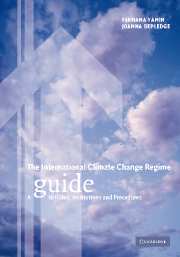Book contents
- Frontmatter
- Contents
- List of figures
- List of tables
- List of boxes
- Foreword by Joke Waller Hunter, Executive Secretary, FCCC
- Preface and acknowledgements
- List of abbreviations
- 1 Introduction
- 2 Overview
- 3 Regime participants
- 4 Objective and principles
- 5 Mitigation commitments
- 6 Flexibility mechanisms
- 7 Research, systematic observation, education, training and public awareness
- 8 Adaptation
- 9 Impacts of response measures
- 10 Finance, technology and capacity-building
- 11 Reporting and review
- 12 Compliance
- 13 Institutions
- 14 The negotiation process
- 15 Scientific and technical input
- 16 Administering the regime
- 17 Linkages
- 18 Evolution of the regime
- 19 Conclusion: taking stock and moving forward
- Appendix I List of Parties, their groups and key statistics
- Appendix II Annex I Party fact sheets: emissions, targets and projections for Annex I Parties and groupings
- Appendix III Table of Articles, issues and COP Decisions
- Bibliography
- Index
19 - Conclusion: taking stock and moving forward
Published online by Cambridge University Press: 16 July 2009
- Frontmatter
- Contents
- List of figures
- List of tables
- List of boxes
- Foreword by Joke Waller Hunter, Executive Secretary, FCCC
- Preface and acknowledgements
- List of abbreviations
- 1 Introduction
- 2 Overview
- 3 Regime participants
- 4 Objective and principles
- 5 Mitigation commitments
- 6 Flexibility mechanisms
- 7 Research, systematic observation, education, training and public awareness
- 8 Adaptation
- 9 Impacts of response measures
- 10 Finance, technology and capacity-building
- 11 Reporting and review
- 12 Compliance
- 13 Institutions
- 14 The negotiation process
- 15 Scientific and technical input
- 16 Administering the regime
- 17 Linkages
- 18 Evolution of the regime
- 19 Conclusion: taking stock and moving forward
- Appendix I List of Parties, their groups and key statistics
- Appendix II Annex I Party fact sheets: emissions, targets and projections for Annex I Parties and groupings
- Appendix III Table of Articles, issues and COP Decisions
- Bibliography
- Index
Summary
Introduction
The previous chapters of this book presented a comprehensive and objective guide to the rules, institutions and procedures of the climate regime. Our main aim in doing so was to make the regime more accessible. An additional hope was to encourage an informed assessment of the merits of what has been achieved, as well of the limitations that remain. We realise that few policy-makers have the time to reflect deeply on the overall direction of climate rules and the ‘health’ of climate institutions to see if these are performing at their best. Increased specialisation, policy linkages and travel commitments, on top of the demands of deepening domestic implementation processes, all take a toll. And, of course, climate change is not the only global challenge. Eradicating poverty, funding AIDS research, creating financial stability, progressing gender equality, financing biodiversity conservation, and securing peace and security, to name a few, compete for resources and time, notwithstanding the vital contribution each makes to achieving sustainable development and the Millennium Development Goals which climate change itself now potentially threatens.
Writing this book gave us the opportunity to think beyond the immediate demands of COP meetings. Although the achievements of the climate regime are impressive, it is also true to say that nearly all Parties are struggling to implement their commitments, and new challenges seem to emerge faster than older ones can be solved.
- Type
- Chapter
- Information
- The International Climate Change RegimeA Guide to Rules, Institutions and Procedures, pp. 560 - 573Publisher: Cambridge University PressPrint publication year: 2004



